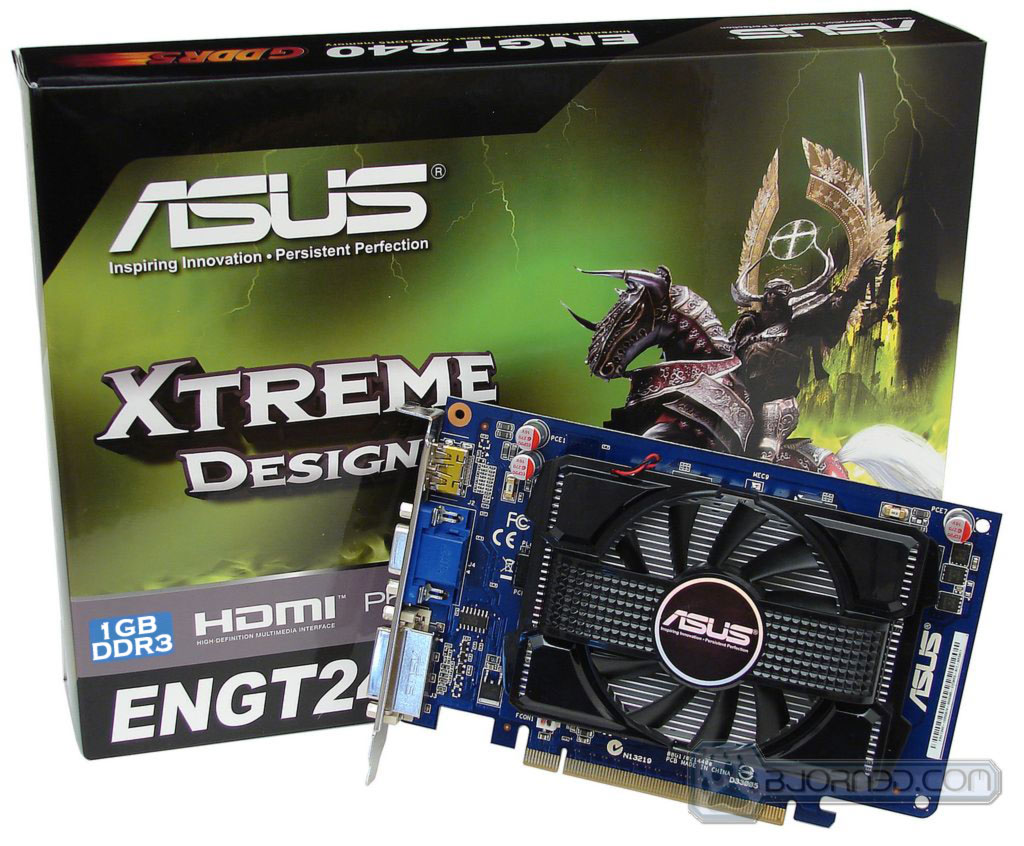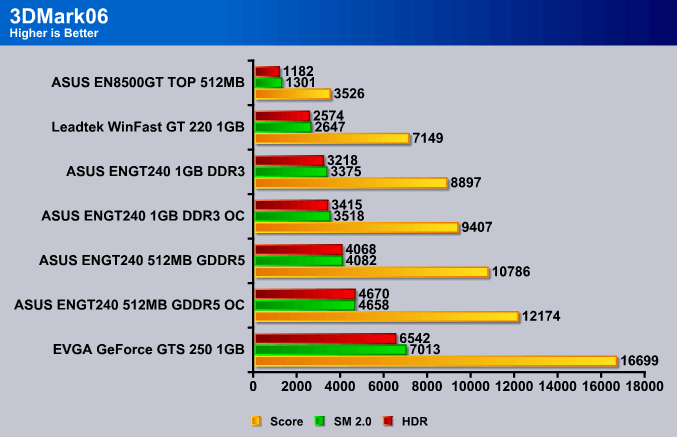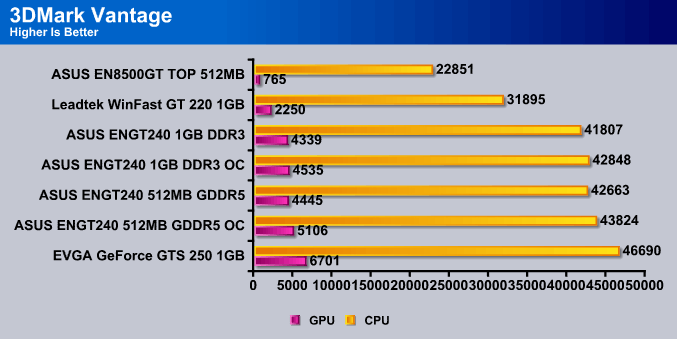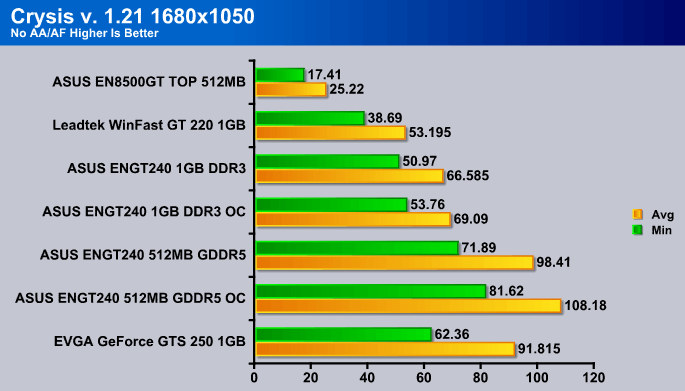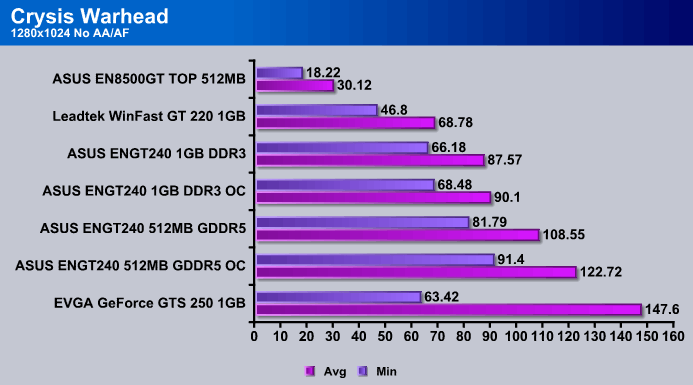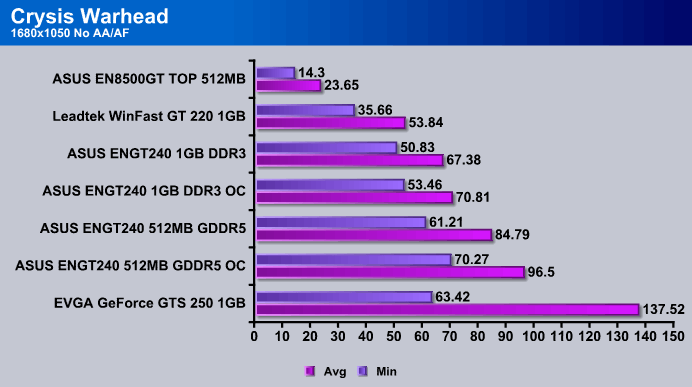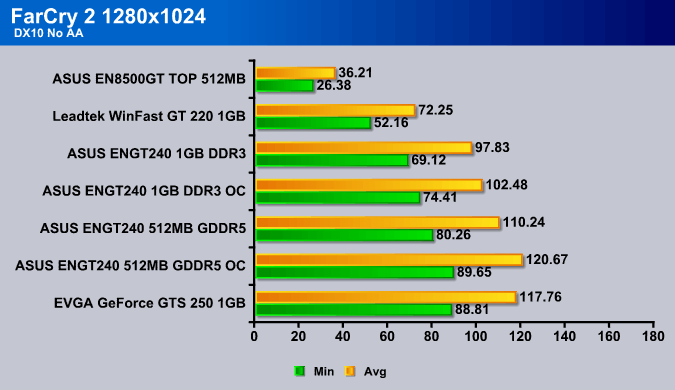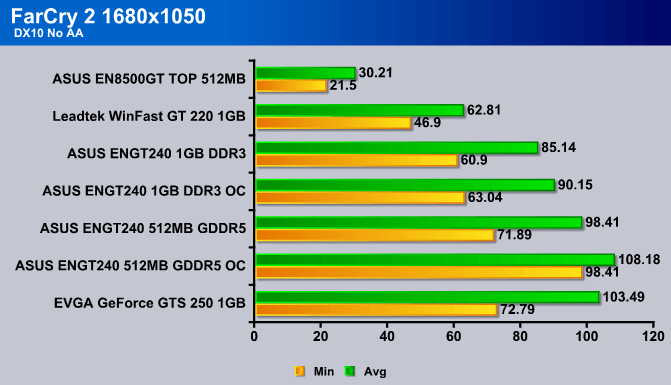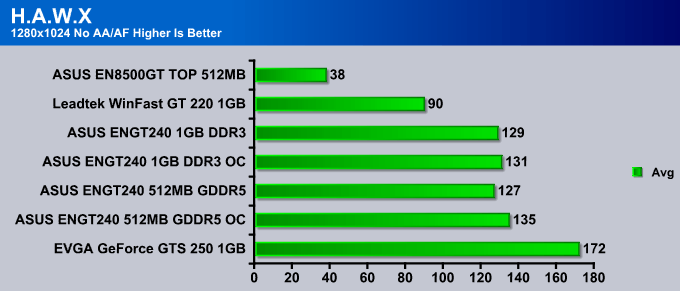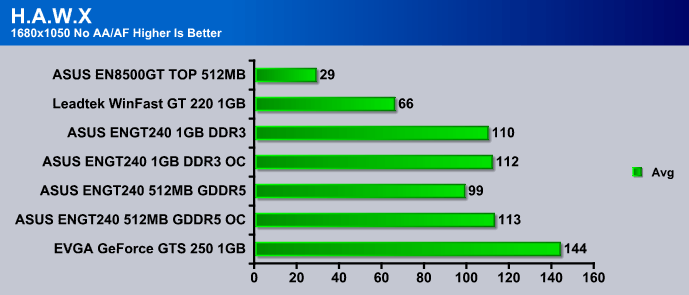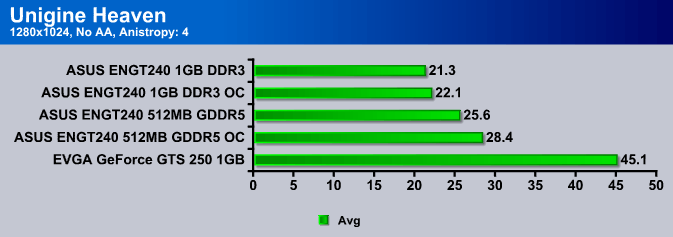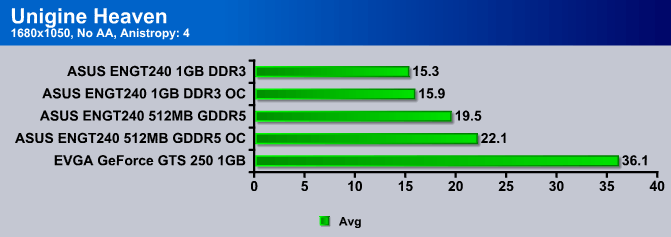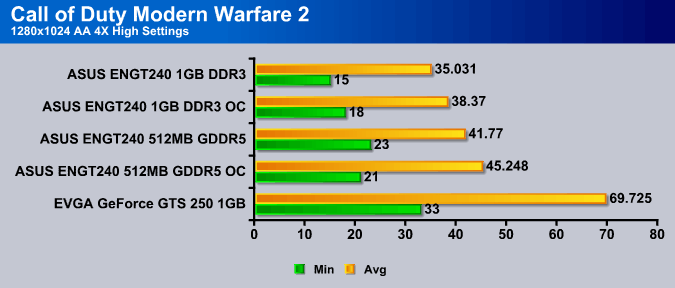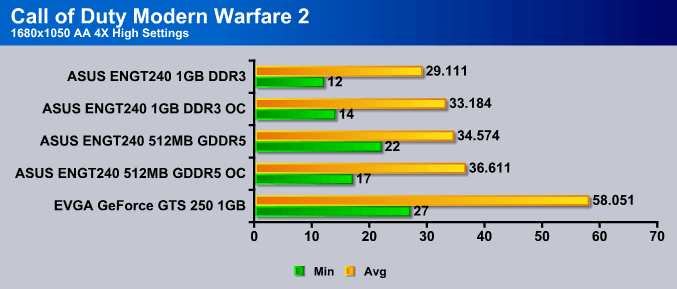We recently reviewed the ASUS ENGT240 512MB GDDR5 video card. This time we will be taking a look at the ASUS ENGT240 1GB DDR3 video card. How will it perform. Come and check it out!
Introduction
A while ago we looked at the ASUS ENGT240 512MB GDDR5 video card, but this time we are taking a look at the new ASUS ENGT240 1GB DDR3 video card. The difference between the two cards is their memory type, size and the memory speed. It will be a very interesting comparison to see which one will perform better. The GT 240 that has 1GB but slower DDR3 memory or the 512MB card that has a faster GDDR5 memory.
The ASUS ENGT240 1GB DDR3 video card runs in a very affordable price at $99 on Newegg. In our opinion it is a great card for mainstream gaming PCs. The ENGT240 is a very quiet, small, and power efficient mainstream card that won’t be a dissapointment to HTPC users and mild gamers. This video card also comes very handy for those looking forward for some PhysX action. You might have a powerful card that renders your games but by having one of these little beast in your system as a dedicated PhysX card, it could bring up your framerates tremendously.
There are two editions of this ASUS ENGT240 video card. One of them is the 512MB GDDR5 model which we have reviewed a while ago and the 1024MB DDR3 model which we are looking at now. Both of these edition come with the new Xtreme Design that ASUS has implemented on their cards. These Xtreme Design cards come with Performance, Safety and Reliability. For Performance ASUS has included SmartDoctor, a utility that we will go into more depth on the following pages, and GamerOSD, a real-time in-game overlcocking tool. Next up the Safety features implemented on the card are fuse protections which deliver double the over-current protection for risk-free computing, and EMI shild that blocks radiations to protect user’s health and improve 66% graphics clarity. and finally the Reliability brings double reinforment and crack prevention for the GPU, and dust-proof fan that helps extend lifespan by 25%. Now with all this said, let’s take a look how this card will keep up with the other GT240 which we have reviewed a while ago.
Features
- Powered by NVIDIA GeForce GT240
- NVIDIA PhysX Ready
- NVIDIA CUDA Technology
- NVIDIA PureVideo HD technology
- Dual-link DVI Support
- Full Microsoft DirecX 10.1 Support
- Microsoft Windows 7 Support
ASUS Exclusive Innovations
- Native HDMI support
- ASUS Xtreme Design Delivers:
- No.1 Performance
- No.1 Safety
- No.1 Reliability
- PCI Express & PCI Express 2.0 Support
- ASUS Splendid
- ASUS GamerOSD
- ASUS SmartDoctor
No.1. Performance
|
|
|
No.1 Safety
 |
|
 |
|
No.1 Reliability
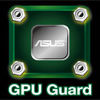 |
|
 |
|
Specifications
Here are some of the basic specifications of the ASUS ENGT240 512MB GDDR5 video card.
| Specifications | ASUS ENGT240 512MB GDDR5 |
|---|---|
| GPU |
|
| Graphics BUS |
PCI Express 2.0 (fully backwards compatible with PCI Express) |
| Memory Size |
1024MB DDR3 |
| GPU/Memory Clock |
550/790MHz |
| Output |
Dual-Link DVI, VGA, HDMI |
| Memory Interface |
128-bit |
| Stream Process |
96 |
| RAMDACs (MHz) |
400MHz |
| Package contents |
ASUS ENGT240 1024MB DDR3 Video Card Driver and Manual CD Quick Installation Guide |
| System Requirements |
Windows XP/ Vista/ 7 PCI Express or PCI Express 2.0-compliant motherboard with one x16 graphics slot DVD ROM drive for software installation A VGA or DVI compatible monitor |
| Software Bundled |
GamerOSD, SmartDoctor, Splendid |
| Parts Warranty |
3 year limited |
| Labor Warranty |
3 year limited |
| DirectX |
DirecX 10.1 |
We can see that the ASUS ENGT240 comes with a Driver CD, Manual CD, a quick installation guide and that’s it. We would think that perhaps ASUS would throw in a adapter with the card, however, this is not the case. In my opinion it is not needed since most of the monitors now use DVI connector anyway, and the card is compatible with HDMI as well. This means that you can also use your home theatre HDTV with the video card.
Unfortunatelly the ENGT240 does not come with SLI capability. It would have been nice to see how well it would compare to its higher end GTS 250 and 260 video cards.
| Model | ENGT240 512MB GDDR5 | ENGT240 1024MB DDR3 |
| Graphic Bus | PCI-Express 2.0 | PCI-Express 2.0 |
| GPU | NVIDIA ® GeForce® GT 240 | NVIDIA ® GeForce® GT 240 |
| Core Clock | 550MHz | 550MHz |
| Memory Data Rate | 850MHz (3.4Gbps) | 1580MHz |
| Memory Size | 512MB GDDR5 | 1024MB DDR3 |
| Memory Bandwidth | 128bit | 128bit |
| RAMDACs | 400MHz | 400MHz |
| Output | Dual-Link DVI, VGA, HDMI | Dual-Link DVI, VGA, HDMI |
There are two models of the ASUS ENGT240. The 512MB GDDR5 model and the 1024MB DDR3 model. While the 512MB GDDR5 video card will probably be faster in most cases than the 1024MB DDR3 video card, the 1024MB video card will come handy in memory intensive gaming where tons of textures and geometry need to be loaded into the memory.
Let’s take a look at what we will be comparing in our review.
| Major GPU Specifications | ||||
| GPU | 8500 GT | GT 220 | GT 240 | GTS 250 |
| GPU frequency | 450MHz | 625MHz | 550MHz | 756MHz |
| Memory frequency | 400MHz | 790MHz | 790MHz | 1100MHz |
| Memory bus width | 128-bit | 128-bit | 128-bit | 256-bit |
| Memory type | DDR2 | DDR3 | DDR3 | GDDR3 |
| Memory quantity | 512MB | 1024MB | 1024MB | 1024MB |
| Number of ALUs | 16 | 16 | 96 | 128 |
| Number of ROPs | 8 | 8 | 8 | 16 |
| Memory bandwidth | 12.8GB/s | 28.8 GB/s | 54.4 GB/s | 71.9 GB/s |
| Number of transistors | 210 million | 486 million | 133 million | 754 million |
| Process | 80nm | 40nm | 40nm | 65nm |
| Die surface area | mm² | 100 mm² | 727 mm² | 330 mm² |
| Generation | 2007 | 2009 | 2009 | 2008 |
While some of these video cards are not the perfect comparison for the ENGT240, it will give us a good overview of the
Driver CD
The Main Menu of the Driver CD is very user friendly. It allows you to easily install the nVidia GT240 drivers as well as install some utilities that come with the ASUS ENGT240.
Some of these utilities that come with the video card are GamerOSD, SmartDoctor, and Splendid. Please read ahead to find out more about these different utilities that ASUS decided to include with this video card.
Gamer OSD
GamerOSD is a basic application advertised by ASUS to be a “real-time overclocking, benchmarking and video capturing” tool. It has three functionalities activated by hotkeys in-game, which allow for screen capturing (picture or video) and GamerOSD’s main functionality, overclocking and benchmarking.
The main hotkey brings up an in-game overlay which allows for adjusting the display (gamma, brightness, and congrast) and other dignostic features.
SmartDoctor
ASUS SmartDoctor is a program which contains a group of tools which have various features and monitors.
Users are able to monitor fan speed, power level, and temperature, and are able to quickly control overclocking speeds with a manual slide bar.
Splendid
Finally, Splendid is a somewhat hidden tool which claims to enhance viewing experience when watching DVDs or playing back MPEG/WMV files. When put to the test, Splendid did make a visible different, but it was minimizing at best.
As seen in the given example, Splendid simply distorts picture levels in an attempt to make viewing more pleasant and clear for the user. Its purpose is interesting, but its execution is poor.Results may vary on different monitors and settings.
A closer look
The ASUS ENGT240 comes in a very small but colorful box. The shipping box was a standard brown shipping box with tons of filling to make sure the cards arrive without any damage. As you can see the box is not damaged at all which proves how well it was shipped. We can also see some of the key features of the video card like the Extreme Design, the 1024MB DDR3 memory, HDMI output connector and PhysX compatibility.
Here are few more angles of the boxing of the ENGT240 video card. On the second picture we can see that there is a very sturdy white box inside the main boxing.
Click Image For a Larger One
Here we are taking a look at the white boxing and how it is organized inside. When I opened up the box, the first thing that showed up was the video card. Right under the video card, you need to lift the inside of the box up in order to reveal the Driver CD, the Manual CD, and the Quick Installation Guide.
This is the small monster we will be testing today. The ENGT240. You can see that it is a small card and also kept cooled with a large fan and heatsink. Other manufactorers include small fans with their mainstream video cards which are a big problem if you do not like noise. With a larger fan and heatsink you can cool down the same card effectively and without any necessary noise.
Here is the top and bottom view of the card. We can now clearly see that the fan is much bigger than what would usually be included with the video cards. The back of the card shows a simple 4-screw installation for the heatsink and fan on the ENGT240.
Looking from the side, we can see that the heatsink does not cover up the memory. Unfortunatelly this is not the best thing, however the way the fan is designed allows plenty of air circulation over the memory.
Two more pictures show the card from all angles. On the second picture we can see all the output connectors. We can see a dual-link DVI connecotor, a VGA connector, and a HDMI connector which will come very handy for those using HDTVs or HDMI compatible monitors.
If we lay down the cards, we can see that the heatsink and fan design isn’t completely single slot based. It is a bit more than a single slot, but not a complete 2-slot design. From what we have tested. Some other cards that do not stick out on their back side can still fit in the other PCI/PCI-E slots.
Here is the Quick Installation Guide, the Driver CD, and the Manuals CD included with the ENGT240 1024MB DDR3 video card. Let’s take a look at the video card in action.
Finally, these two images take a look at the actual size of the video card. According to the measurements, the video card is about 7.4 inches in length.
Testing Methodology
To test this card, we did a fresh load of Windows 7 Professional 64-bit and applied all the patches and updates for the OS, then we updated all the motherboard drivers and made sure that we had the latest video card drivers.We ran each test 3 times and averaged the results, the average of those results are reported here. Below is a detailed list of the components used during testing.
| Test Rig | |
| Case | Silverstone Temjin Series TJ10B |
| CPU | Intel Core I7 920 Extreme 2.66Ghz @ 3.8Ghz (vcore 1.35v) |
| Motherboard | ASUS P6T SE X58 Motherboard |
| Ram | OCZ DDR3-12800 1600Mhz (7-7-7-18 1.66v) 12GB Kit |
| CPU Cooler | Custom Water Cooling Loop from AcousticPC |
| Hard Drives |
2x Western 2x Seagate |
| Optical | Sony DVD R/W |
| GPUs Tested |
EVGA GeForce GTS 250 1024MB ASUS EN8500GT TOP 512MB Leadtek WinFast GT 220 1024MB ASUS ENGT240 512MB GDDR5 ASUS ENGT240 1GB DDR3 |
| Case Fans |
2x Noctua NF-P12 120mm Fans – Top on Radiator 1x Silverstone 120mm Fan – Back 1x Silverstone 120mm Fan – Front 1x Noctua NF-P12 120mm Fan – Hard Drives Front |
| Additional Fans |
1x Cool-It Memory Fan Cooler |
| PSU |
Sapphire PURE 1250 Watt Modular Power |
| Mouse | Logitech G5 |
| Keyboard | Logitech G15 |
Overclocking
To overclock the ASUS ENGT240 I used
| Core Clock | Shader Clock | Memory Clock |
|---|---|---|
| 610MHz |
1486MHz |
1700MHz |
TEMPERATURES
Temperature is one of the parts that some current manufacturers don’t really pay attention too. It is time to come out with new technologies allowing us to further develop our chips and maintain low temperatures. This is why we at Bjorn3D pay close attention to making sure that each product is measured and reported with accurate temperature readings.
Stock
| Idle Temperature (Fan Speed: Auto) | Load Temperature (Fan Speed: Auto) |
|---|---|
| 32 | 54 |
Overclocked
| Idle Temperature (Fan Speed: 100%) | Load Temperature (Fan Speed: 100%) |
|---|---|
| 29 | 60 |
The ASUS ENGT240 1GB DDR3 video card is one of the coolest video cards we have worked with with a silent cooler that it comes with. I am very impressed with the cooling performance on this card.
Synthetic Benchmarks & Games
The benchmarks we ran to test for the performance of the card compared to other cards.
| Synthetic Benchmarks & Games | |
| 3DMark 06 | |
| 3DMark Vantage | |
| Crysis | |
| Crysis Warhead | |
| Far Cry 2 | |
| H.A.W.X. | |
| S.T.A.L.K.E.R. Clear Sky | |
| Unigine Heaven | |
| Call of Duty 4: Modern Warfare | |
3DMARK06 V. 1.1.0
3DMark06 developed by Futuremark, is a synthetic benchmark used for universal testing of all graphics solutions. 3DMark06 features HDR rendering, complex HDR post processing, dynamic soft shadows for all objects, water shader with HDR refraction, HDR reflection, depth fog and Gerstner wave functions, realistic sky model with cloud blending, and approximately 5.4 million triangles and 8.8 million vertices; to name just a few. The measurement unit “3DMark” is intended to give a normalized mean for comparing different GPU/VPUs. It has been accepted as both a standard and a mandatory benchmark throughout the gaming world for measuring performance.
The performance drop from the ENGT240 512MB GDDR5 video card is tremendous. I was not expecting such a drop however I did know that the performance is going to be a bit lower. Not even with the overclocked card could I achieve the stock speed of the ENGT240 512MB GDDR5.
3DMark Vantage
For complete information on 3DMark Vantage Please follow this Link:
www.futuremark.com/benchmarks/3dmarkvantage/features/
The newest video benchmark from the gang at Futuremark. This utility is still a synthetic benchmark, but one that more closely reflects real world gaming performance. While it is not a perfect replacement for actual game benchmarks, it has its uses. We tested our cards at the ‘Performance’ setting.
Currently, there is a lot of controversy surrounding
Same thing went with Vantage, however this tame the card got a bit closer to the other GT240 512MB video card. I think this only looks visually closer but the actual ratio is the same as in 3DMark06. Ther performance increase from the GT220 is very nice though!
Crysis v. 1.21
Crysis is the most highly anticipated game to hit the market in the last several years. Crysis is based on the CryENGINE™ 2 developed by Crytek. The CryENGINE™ 2 offers real time editing, bump mapping, dynamic lights, network system, integrated physics system, shaders, shadows, and a dynamic music system, just to name a few of the state-of-the-art features that are incorporated into Crysis. As one might expect with this number of features, the game is extremely demanding of system resources, especially the GPU. We expect Crysis to be a primary gaming benchmark for many years to come.
The Settings we use for benchmarking Crysis
Here comes the interesting part. Looks like ther performance of the Memory plays a big role in Crysis. the ENGT240 with DDR3 lacked some performance while the GDDR5 model even passed the GTS 250. We can see that cards with faster memory perform better under these settings in Crysis.
CRYSIS WARHEAD

Crysis Warhead on the other hand seems to be the other way around. Memory speed doesn’t seem to effect it as much as the overall performance of the cards. The 1GB model got a bit closer to the 512MB model of the ENGT240, however, it was still behind a bit.
Far Cry 2
Far Cry 2, released in October 2008 by Ubisoft, was one of the most anticipated titles of the year. It’s an engaging state-of-the-art First Person Shooter set in an un-named African country. Caught between two rival factions, you’re sent to take out “The Jackal”. Far Cry2 ships with a full featured benchmark utility and it is one of the most well designed, well thought out game benchmarks we’ve ever seen. One big difference between this benchmark and others is that it leaves the game’s AI (Artificial Intelligence) running while the benchmark is being performed.
The Settings we use for benchmarking FarCry 2
There is nothing to different on FarCry 2. The speed ration seems to be very close to the other tests performed previously. Let’s see if HAWX will have anything interesting to show us.
HawX
The story begins in the year 2012. As the era of the nation–state draws quickly to a close, the rules of warfare evolve even more rapidly. More and more nations become increasingly dependent on private military companies (PMCs), elite mercenaries with a lax view of the law. The Reykjavik Accords further legitimize their existence by authorizing their right to serve in every aspect of military operations. While the benefits of such PMCs are apparent, growing concerns surrounding giving them too much power begin to mount.
Tom Clancy‘s HAWX is the first air combat game set in the world–renowned Tom Clancy‘s video game universe. Cutting–edge technology, devastating firepower, and intense dogfights bestow this new title a deserving place in the prestigious Tom Clancy franchise. Soon, flying at Mach 3 becomes a right, not a privilege.
All the settings where set to low.
HAWX has some very interesting results. We happend to more frames per second with the 1GB card rather than the 512MB card, however in the overclocking of the 1GB card, the overclocking performance was lacking to outperform the GDDR5 512MB ENGT240 model.
S.T.A.L.K.E.R. Clear Sky
S.T.A.L.K.E.R. Clear Sky is the latest game from the Ukrainian developer, GSC Game World. The game is a prologue to the award winning S.T.A.L.K.E.R. Shadow of Chernoble, and expands on the idea of a thinking man’s shooter. There are many ways you can accomplish your mission, but each requires a meticulous plan, and some thinking on your feet if that plan makes a turn for the worst. S.T.A.L.K.E.R. is a game that will challenge you with intelligent AI, and reward you for beating those challenges. Recently GSC Game World has made an automatic tester for the game, making it easier than ever to obtain an accurate benchmark of Clear Skie’s performance.

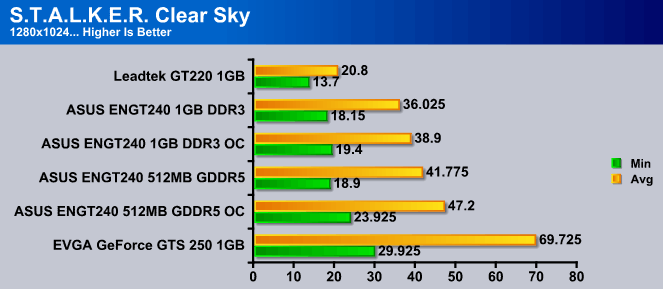
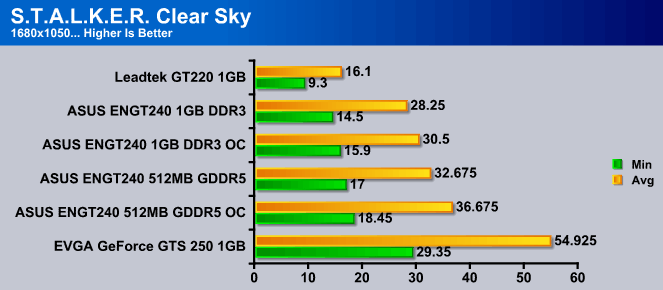
unigine heaven
The settings we use for benchmarking Unigine Heaven
Now Unigine Heaven is a benchmark tool that we will be using a bit more as newer DX11 cards come out. Due to the card only supporting DX10, we could only run the API under the DX10 settings. We could see that the ENGT240 1GB DDR3 video card suffered big time in this benchmark.
CAll of duty modern warfare 2
The settings we use for benchmarking Call of Duty Modern Warfare 2
Call of Duty Modern Warfare 2 is quite playable at 1280 x 1024, however the with the ENGT240 512MB card, it was even more enjoyable. Playing it on higher resolutions is a bit lagish so I would recommend this card to those only playing on smaller monitors.
Conclusion
While the ASUS ENGT240 1GB DDR3 video card performed good enough for some mild gaming action, it has quite a bit fallen behind the ASUS ENGT240 512MB GDDR5 video card. The ENGT240 512MB GDDR5 video card performed good enough that we could recommend it as a Bang for the Buck item, however I don’t feel the ENGT240 1GB DDR3 video falls into that category due to it’s lack of performance.
Other than that the video card performed very well. It was silent, and the temperatures were great!
The size of the video card and the power consumption is excellent which makes this video card excellent for HTPCs. The silent fan is also another reason why a HTPC user should go with this card instead of other GT 240’s that come with smaller fans and coolers.
| OUR VERDICT: ASUS ENGT240 1GB DDR3 Video Card | ||||||||||||||||||
|
||||||||||||||||||
| Summary: Due to the fact that the ENGT240 512MB GDDR5 video card performed much better than the ENGT240 1GB DDR3 video card, the ASUS ENGT240 1GB DDR3 video card will only recive “Bjorn3D’s Bronze Bear Award”. |
 Bjorn3D.com Bjorn3d.com – Satisfying Your Daily Tech Cravings Since 1996
Bjorn3D.com Bjorn3d.com – Satisfying Your Daily Tech Cravings Since 1996
